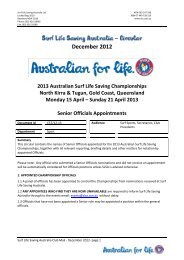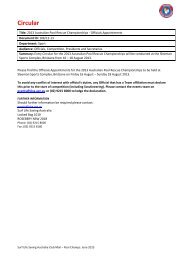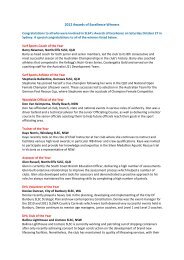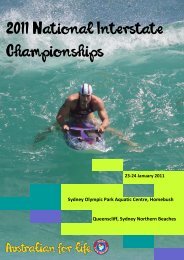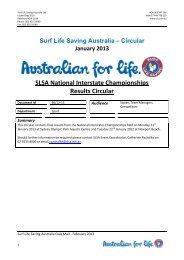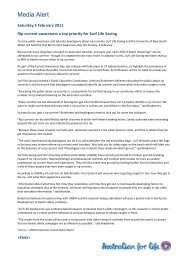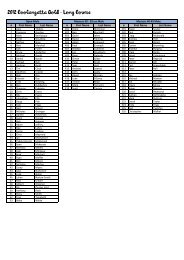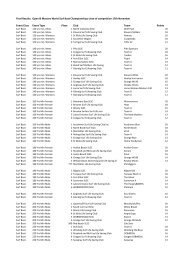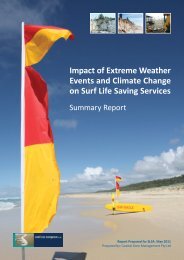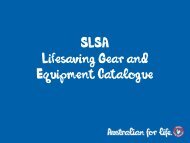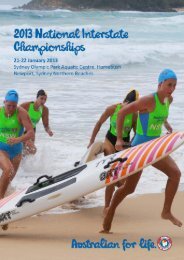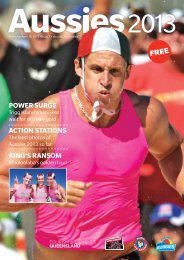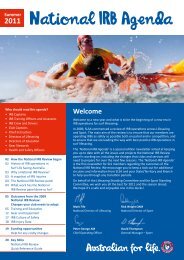Australian Lifeguard magazine - Surf Life Saving Australia
Australian Lifeguard magazine - Surf Life Saving Australia
Australian Lifeguard magazine - Surf Life Saving Australia
You also want an ePaper? Increase the reach of your titles
YUMPU automatically turns print PDFs into web optimized ePapers that Google loves.
new australian standardsThe new <strong><strong>Australia</strong>n</strong> Standard for water safety signsand beach safety flags has recently been released afterindustry wide consultation over more than eight years.ADAM WEIR, SLSA’s Coastal Risk Manager providesa short summary of the changes. For a complete copyof the latest Standards visit the SAI Global Info Store(http://infostore.saiglobal.com/store) and search forstandard “2416”The <strong><strong>Australia</strong>n</strong>/New Zealand Standard 2416:2010 Water SafetySigns and Beach Safety Flags was released on 12 November2010. This standard supersedes AS 2416:2002 and is anadoption, (with some national modifications), of ISO 20712-2:2007, Water Safety Signs and Beach Safety Flags, Part 2:Specifications for Beach Safety Flags – Colour, Shape, Meaningand Performance.A/NZS 2416:2010Symbol No. WSW015- Warning; StrongcurrentsExamples of beach flagaugmentation “feather”(as shown in A/NZS 2416:2010.2- page 9)A/NZS 2416:2010Symbol No. WSW015 -Warning; Strong currents(with diamond shapedbackground)A/NZS 2416:2010Symbol No. WSW015The blue flags (indicate buffer zonefor surf craft riders) will be replacedby black and white quartersSummary of the major changes affectinglifeguard services• Black-white quartered flags will replace blue board ridingbuffer (boundary) flags• Feathered flags are now included in the standard• Triangles added to options for international symbol signshapes (with diamonds)• New ‘Strong Currents’ warning symbol as a valid alternativeto the ‘swimming not advised’ symbol• Symbols available specific to emergency management inthe event of a tsunami are now availableSLSA has developed an implementation plan to guidelifesaving and lifeguard services through the changes toensure national consistency. <strong><strong>Life</strong>guard</strong> Services with questionsregarding the new standards should contact their SLS stateoffice in the first instance or Adam Weir at SLSA.It’s in black & white:<strong>Surf</strong>ing flags no LONGer blueThey’ve been a familiar sight on our beaches for many years,but a change in the <strong><strong>Australia</strong>n</strong> Standards recently releasedmeans the blue flags used to indicate a buffer zone for surfcraft riders near the red and yellow flags will be replaced byblack and white quarters next summer. It all comes downto standardisation with the rest of the world, and for 3,450beaches around the world the blue flag represents a eco-labelawarded based on compliance with 32 criteria covering theaspects of: Environmental Education and Information, WaterQuality, Environmental Management and Safety and Services.Adam Weir, Coastal Risk Manager for <strong>Surf</strong> <strong>Life</strong> <strong>Saving</strong><strong>Australia</strong> says the new standard to indicate a ‘surfboardand other water craft zone or boundary’ is important to getconsistency internationally. “The adoption of the black andwhite quartered flag brings <strong>Australia</strong> into line with the restof the world, making it easier for tourists and visitors tounderstand its meaning.” he said. Asked whether it wouldcause confusion in a country where the beach is at the heartof its culture and surfing is its blood, Mr Weir was confidentthe transition to the new flags would be unproblematic.“There may be some confusion initially, but since they areusually displayed in proximity to the red and yellow flags inconjunction with other information signage this confusion willhopefully be minimised.” He said. “By matching the rest of theworld, the upside will be that visitors from other countries thatcomply with the International Standard will already know andunderstand what the black and white quartered flag signifies.”Weir advises that there will be a ‘teething period’ and thatSLSA has a change management plan in place in which it will beworking with lifesaving services, local councils and the surfingindustry to ensure a smooth transition.“As the new black and white quartered flag is rolled outat locations around <strong>Australia</strong> there will be correspondingchanges to any existing education materials that reference thesuperseded blue flag.” said Weir. “SLSA will be updating its flagrelated educational material to reflect the change as the blackand white quartered flag is rolled out and will be advising othereducation providers to do the same. The blue flags should bephased out as they need to be replaced due to normal wear andtear. Any new ‘surfboard and other water craft zone or boundary’flags should be black and white quartered.” <strong><strong>Australia</strong>n</strong> <strong><strong>Life</strong>guard</strong>Service (NSW) Manager Andrew McIvor doesn’t think there’ll bea problem with the transition.“We’re not anticipating any issues from the new standard.” SaidMcIvor “Our lifeguards are tasked to communicate with beachgoers as much as possible, it’s part of being a educational andpreventative service in the first instance.” The new black andwhite quartered flags, including a version with a feather similarto that which has been adopted in the same <strong><strong>Australia</strong>n</strong>Standards release, is to be made available in the SLS <strong>Surf</strong> Shop(www.surfshop.slsa.com.au) as soon as possible. Both SLSservices and Local Councils can purchase from the online <strong>Surf</strong>Shop and will be advised when they are available.<strong><strong>Life</strong>guard</strong> · Issue 5 Summer 2011 · 33



